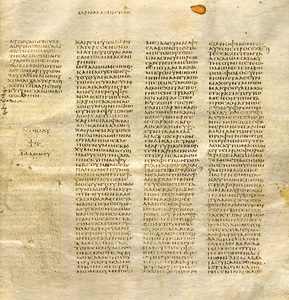Review of Reading Romans in Context Paul and Second Temple Judaism
The Origin of Christianity
The Belatedly Geza Vermes on the transition from Jewish Christians to Gentiles
Noah Wiener Jan 29, 2022 50 Comments 99831 views

A turning signal in the Jesus movement, Peter baptizes the Roman centurion Cornelius, the first not-Jewish Christian, in Jerusalem (Acts 10), as shown in one of v baptism scenes on a 12th-century baptismal font in St. Bartholomew's Church in Liège, Belgium. Image: Jean-Pol Grandmont.
Today the concept of "Jewish Christians" may audio like a defoliation of two religions. All the same, to empathize the origin of Christianity, ane must begin with the population of Jewish Christians who lived during Jesus' lifetime. In the Nov/December 2012 event of Biblical Archaeology Review, Expressionless Body of water Whorl and early Christianity scholar Geza Vermes explored the origin of Christianity by examining the characteristics of the Jewish Jesus movement to see how it adult into a distinctly gentile religion.
In the New Testament, Jesus only preaches to a Jewish audience. Geza Vermes described the mission of the xi apostles to preach to "all the nations" (Matthew 28:19) every bit a "'post-Resurrection' idea." Afterwards the crucifixion, the apostles began to champion a new organized religion in Jesus and the ranks of the Jesus motility (known every bit "the Way" at the time) swelled to 3,000 Jewish converts. At offset, these followers were distinctly Jewish, following Mosaic law, Temple traditions and dietary customs.
In the free eBook Paul: Jewish Law and Early on Christianity, learn about the cultural contexts for the theology of Paul and how Jewish traditions and law extended into early Christianity through Paul's dual roles as a Christian missionary and a Pharisee.
In BAR, Geza Vermes wrote: "Acts identifies the demographic watershed regarding the composition of the Jesus movement. It began around 40 C.Due east. with the admission into the church building of the family unit of the Roman centurion Cornelius in Caesarea (Acts 10). Afterwards came the gentile members of the mixed Jewish-Greek church building in Antioch (Acts eleven:19–24; Galatians ii:xi–14), likewise as the many heathen converts of Paul in Syria, Asia Minor and Hellenic republic. With them the Jewish monopoly in the new movement came to an finish. Jewish and gentile Christianity was born."
Equally gentiles joined the Jesus movement, focus on Jewish law decreased and we start to see the origin of Christianity as a singled-out faith. Jewish Christians in Jerusalem participated in carve up Jewish services from the gentile Christian population, and while the two groups agreed on Jesus' message and importance, the separate rites and communities led to increasing division between the groups.
Become a Fellow member of Biblical Archaeology Society Now and Get More than Half Off the Regular Price of the All-Admission Laissez passer!
Explore the globe'southward most intriguing Biblical scholarship
Dig into more than 9,000 manufactures in the Biblical Archeology Guild's vast library plus much more with an All-Access laissez passer.


The early-2nd-century Epistle of Barnabas is one of the earliest expressions of gentile Christianity and describes Jesus as quasi-divine. Photo: ©The British Library.
Geza Vermes presents the late first century C.Due east. Jewish Christian Didache equally an important text for understanding the Jewish Jesus motion. The Christian document focuses on Mosaic Constabulary and the honey of God and the neighbor, and describes the observance of Jewish traditions alongside baptism and the recitation of "Our Father." The Didache treats Jesus equally a charismatic prophet, referring to Jesus with the term pais, a discussion for retainer or kid that is also used for Male monarch David, rather than the "Son of God."
By contrast, the early on 2d century Epistle of Barnabas shows a distinctly gentile Christianity in its presentation of the Hebrew Bible every bit allegory instead of covenantal fact. The clearly divinized Jesus in this document is distanced from the Jewish Christians and the dissever betwixt the Christian communities continued to widen over fourth dimension. Geza Vermes writes that afterward Hadrian's suppression of the Second Jewish Revolt, the Jewish Christians quickly became a minority grouping in the newly established church building. At this point we can see the origin of Christianity as a distinctly non-Jewish religion; tardily in the second century, the Jewish Christians either rejoined their Jewish peers or become part of the newly gentile Christian church.
For more on the origin of Christianity, read Geza Vermes's "From Jewish to Gentile: How the Jesus Movement Became Christianity" as it appeared in Biblical Archaeology Review, November/December 2012.
Not a BAS Library member even so? Bring together the BAS Library today.
This Bible History Daily feature was originally published in November 2012.
Related reading in Bible History Daily:
The Archaeological Quest for the Earliest Christians: Part i and Part 2 by Douglas Boin
Roman Emperor Nerva's Reform of the Jewish Revenue enhancement by Nathan T. Elkins
When Did Christianity Begin to Spread?
Uncovering the Jewish Context of the New Testament
Amy-Jill Levine reveals what Jews (and Christians) should know about Christian scripture and Jesus the Jew
Alternative Facts: Domitian's Persecution of Christians by Mark Wilson
Source: https://www.biblicalarchaeology.org/daily/biblical-topics/new-testament/the-origin-of-christianity/
0 Response to "Review of Reading Romans in Context Paul and Second Temple Judaism"
Post a Comment